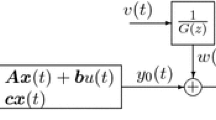Abstract
In the paper a three-stage, semirecursive scheme for the Wiener-Hammerstein system identification is proposed. The algorithm combines both parametric and nonparametric strategies and allows to recover linear and nonlinear subsystems directly from the noisy inputoutput data. As to the nonlinearity, the main idea is based on the recursive kernel censoring of measurements, while linear dynamics are recovered by a special kind of deconvolution. Efficiency of the obtained estimates is justified by numerical example.
Access this chapter
Tax calculation will be finalised at checkout
Purchases are for personal use only
Preview
Unable to display preview. Download preview PDF.
Similar content being viewed by others
References
1. Giri, F., Bai, E.: Block-Oriented Nonlinear System Identification. Lecture Notes in Control and Information Sciences 404, Springer (2010)
2. Greblicki, W., Pawlak, M.: Nonparametric System Identification. Cambridge University Press; 1 edition (2008)
3. Mzyk, G.: Wiener-Hammerstein system identification with non–Gaussian input. In: IFAC International Workshop on Adaptation and Learning in Control and Signal Processing. Antalya, Turkey (2010)
4. Mzyk, G.: Nonparametric recovering of nonlinearity in Wiener–Hammerstein systems. In: Proceedings of the 9th International Conference on Informatics in Control, Automation and Robotics, ICINCO. pp. 439–445. IEEE, Rome, Italy (2012)
5. Mzyk, G.: Combined Parametric-Nonparametric Identification of Block-Oriented Systems. Lecture Notes in Control and Information Sciences 454, Springer (2014)
6. Mzyk, G.,Wachel, P.: Kernel–based identification of Wiener–Hammerstein system. Accepted for publication in Automatica (2017)
7. Pawlak, M., Hasiewicz, Z., Wachel, P.: On nonparametric identification of Wiener systems. IEEE Transactions on Signal Processing 55(2), 482–492 (2007)
8. Sjöberg, J., Lauwers, L., Schoukens, J.: Identification of Wiener–Hammerstein models: Two algorithms based on the best split of a linear model applied to the SYSID’09 benchmark problem. Control Engineering Practice 20(11), 1119–1125 (2012)
9. Sjöberg, J., Schoukens, J.: Initializing Wiener–Hammerstein models based on partitioning of the best linear approximation. Automatica 48(2), 353–359 (2012)
10. Śliwiński, P., Hasiewicz, Z.: Computational algorithms for multiscale identification of nonlinearities in Hammerstein systems with random inputs. IEEE Transactions on Signal Processing 53(1), 360–364 (2005)
11. Śliwiński, P., Hasiewicz, Z., Wachel, P.: A simple scheme for semi-recursive identification of Hammerstein system nonlinearity by Haar wavelets. International Journal of Applied Mathematics and Computer Science 23(3), 507–520 (2013)
12. Westwick, D., Schoukens, J.: Initial estimates of the linear subsystems of Wiener–Hammerstein models. Automatica 48(11), 2931–2936 (2012)
13. Wills, A., Schön, T., Ljung, L., Ninnes, B.: Identification of Hammerstein-Wiener models. Automatica 49(1), 70–81 (2013)
Author information
Authors and Affiliations
Corresponding author
Editor information
Editors and Affiliations
Rights and permissions
Copyright information
© 2017 Springer International Publishing AG
About this paper
Cite this paper
Hasiewicz, Z., Wachel, P., Mzyk, G., Kozdraś, B. (2017). Multistage identification of Wiener-Hammerstein system. In: Mitkowski, W., Kacprzyk, J., Oprzędkiewicz, K., Skruch, P. (eds) Trends in Advanced Intelligent Control, Optimization and Automation. KKA 2017. Advances in Intelligent Systems and Computing, vol 577. Springer, Cham. https://doi.org/10.1007/978-3-319-60699-6_51
Download citation
DOI: https://doi.org/10.1007/978-3-319-60699-6_51
Published:
Publisher Name: Springer, Cham
Print ISBN: 978-3-319-60698-9
Online ISBN: 978-3-319-60699-6
eBook Packages: EngineeringEngineering (R0)




